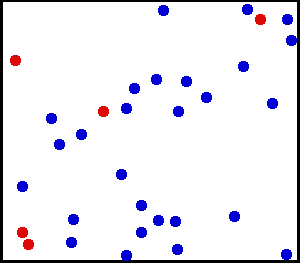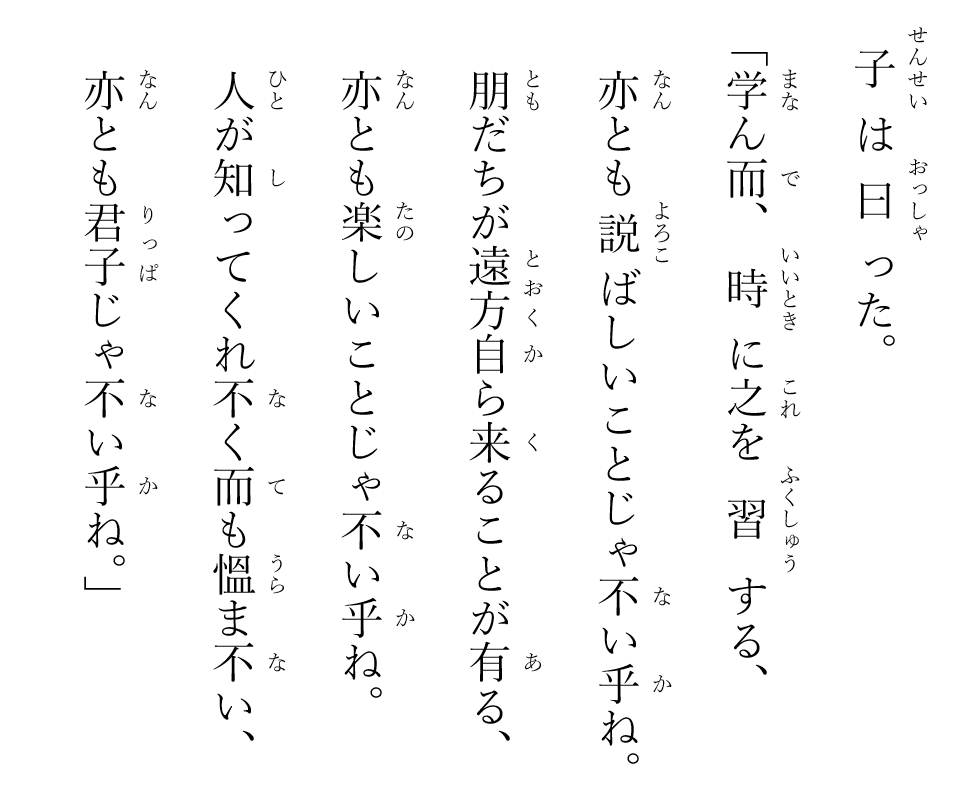Bernoulli's analysis of gas particles (1738)
On the properties and motions of elastic fluids, especially of air
Now that we are considering elastic fluids, we may assign to them a law which agrees with all observed properties thus far. This will allow us to investigate properties that remain insufficiently explored. The main properties of elastic fluids are as follows:
- They have weight.
- They expand in all directions unless confined.
- They can be increasingly compressed under growing compressive forces.
Air is thus constructed in this way, and it is with air in particular that our present reflections are concerned.
Imagine, then, a cylindrical vessel placed vertically, \(ACDB\) (Figure 56), and within it a movable lid \(EF\), upon which a weight \(P\) rests from above. Let the cavity \(ECDF\) contain tiny particles, agitated back and forth with extremely rapid motion. Thus, as these particles strike the lid \(EF\) and sustain it with their continually repeated impacts, they compose a fluid that is elastic. This fluid expands when the weight \(P\) is removed or reduced, and is compressed when the weight is increased. Yet it presses down on the horizontal base \(CD\) just as if it had no elastic force at all: for whether the particles are at rest or in motion, their weight does not change, so that the bottom supports both the weight and the elasticity of the fluid. We will therefore substitute such a fluid—which agrees with the primary characteristics of elastic fluids—for air, and thus explain certain properties already observed in air, and further illustrate others not yet sufficiently considered.
We will consider the particles contained within the cavity of the cylinder as an infinite number, and as they occupy the space \(ECDF\), we will say that they form the natural air, to which all measurements are to be referred. Thus, the weight \(P\) holding the lid in place at position \(EF\) does not differ from the pressure of the atmosphere pressing down upon it, which we will consequently designate by \(P\) in the following. Note, however, that this pressure is by no means equal to the absolute weight of the vertical cylindrical air lid \(EF\) in the atmosphere above it, as some authors have thoughtlessly claimed. But this pressure is equal to the fourth proportional to the surface area of the Earth, the size of the lid \(EF\), and the weight of the entire atmosphere on the Earth's surface.
Let us determine the pressure \(\pi\) required to compress the air from the volume \(ECDF\) to \(eCDf\), assuming that the velocities of the particles remain the same in both the uncompressed and compressed states. Let \(EC = 1, eC = s\). However, when the lid \(EF\) is moved to position \(ef\), it experiences a greater force from the fluid in two ways. First, because the number of particles in relation to the space they occupy is now greater. Second, because each particle hits the lid more frequently.
To correctly calculate the increment caused by the first reason, we will consider the particles as stationary and make the number of particles adjacent to the lid in position \(EF\) equal to \(n\). The same number will apply for the lid in position \(ef\), which is equal to \(ef = \frac{n}{ \left(\frac{eC}{EC}\right)^{2/3}} = \frac{n}{s^{2/3}}\). Let it be noted, moreover, that the fluid we are considering is not more condensed in the lower part than in the upper part—such is the case when the weight \(P\) is, as it were, infinitely greater than the proper weight of the fluid. From this, it is clear that under this condition the force of the fluid is as the numbers \(n\) and \(\frac{n}{s^{2/3}}\), that is, as \(s^{2/3}\) to 1.
As for the second increase, arising from the second cause, it is found by considering the motion of the particles; and thus it appears that impacts happen more frequently the closer the particles are situated to one another. That is, the number of impacts is inversely proportional to the average distance between the surfaces of the particles. And these average distances will be determined accordingly.
Let the particles be spherical. Let \(D\) be the average distance between the centers of the spheres when the lid is at position \(EF\) (uncompressed state). Let \(d\) be the diameter of a sphere (i.e., a particle). Then the average surface-to-surface distance is \(D−d\). In the compressed state, when the volume is reduced by factor \(s\), the center-to-center distance becomes \(D s^{1/3}\) because linear dimensions shrink as the cube root of the volume ratio. It is evident that, in the position of the lid \(ef\), the average distance between the centers of the spheres will be \(Ds^{1/3}\), and therefore the average distance between the surfaces of the spheres will be \(Ds^{1/3}−d\). Therefore, with respect to the second cause, the force of the uncompressed air \(ECDF\) to the force of the compressed air \(eCDf\) is as
$$\frac{1}{D-d} \quad {\rm to} \quad \frac{1}{D s^{1/3}-d}$$or, equivalently, as
$${D s^{1/3}-d} \quad {\rm to} \quad D-d$$Now, taking both causes together, the aforesaid forces will be as
$$s^{2/3}(D s^{1/3}-d) \quad {\rm to} \quad D-d$$ $$\frac{P}{\pi} = \frac{s^{2/3}(D s^{1/3}-d)}{D-d} = \frac{s - s^{2/3}\frac{d}{D}}{1-\frac{d}{D}}$$ We can substitute the ratio of \(D\) to \(d\) with another, more intelligible one: namely, if we suppose the lid \(EF\), pressed down with infinite weight, descends all the way to the position \(mn\), in which all the particles touch one another, and we call the line \(mC\) by the name \(m\), then \(D\) is to \(d\) as 1 is to \(m^{1/3}\). $$\frac{D}{d} = \frac{1}{m^{1/3}}$$Using this ratio, the forces of the uncompressed air \(ECDF\) and of the compressed air \(eCDf\) will finally be in the ratio $$s^{2/3} (s^{1/3} - m^{1/3}) \quad {\rm to} \quad 1 - m^{1/3}$$
or, equivalently, as
$$s - (ms^2)^{1/3} \quad {\rm to} \quad 1 - m^{1/3}$$Therefore, the resulting pressure \(\pi\) is:
$$\pi = \left(\frac{1 - m^{1/3}}{s - (ms^2)^{1/3}} \right)P $$De affectionibus atque motibus fluidorum elasticorum, praecipue autem aeris
[1] Fluida nunc elastica consideraturis licebit nobis talem iis affingere constitutionem, quae cum omnibus adhuc cognitis conveniat affectionibus, ut sic ad reliquas etiam nondum satis exploratas detur aditus. Fluidorum autem elasticorum praecipuae affectiones in eo positae sunt: 1º ut sint gravia, 2º ut se in omnes plagas explicent, nisi contineantur, et 3º ut se continue magis magisque comprimi patiantur crescentibus potentiis compressionis: Ita comparatus est aer, ad quem potissimum praesentes nostrae pertinent cogitationes.

[2] Finge itaque vas cylindricum verticaliter positum ACDB (Figure 56) atque in illo operculum mobile EF, cui pondus P super incumbat: contineat cavitas ECDF corpuscula minima motu rapidissimo hinc inde agitata: sic corpuscula, dum impingunt in operculum EF idemque suis sustinent impetibus continue repetitis fluidum componunt elasticum quod remoto aut diminuto pondere P sese expandit: quod eodem aucto condensatur & quod in fundum horizontalem CD haud aliter gravitat, ac si nulla virtute elastica esset praeditum: sive enim quiescant corpuscula sive agitentur, non mutant gravitatem, ita ut fundum tum pondus tum elasticitatem fluidi sustineat. Tale igitur fluidum quod cum primariis convenit fluidorum elasticorum affectionibus substituemus aeri, atque sic alias, quae jam in aere detectae fuerunt explicabimus aliasque nondum satis perpensas ulterius illustrabimus proprietates.
[3] Corpuscula cavitati cylindri inclusa considerabimus tanquam numero infinita, & cum spatium ECDF occupant, tunc aerem illa dicemus formare naturalem, ad cujus mensuras omnia sunt referenda: atque sic pondus P operculum detinens in situ EF non differt a pressione Atmosphaerae superincumbentis, quam proinde per P in sequentibus designabimus. Notetur autem hanc pressionem minime aequalem esse ponderi absoluto cylindri verticalis aerei operculo EF in atmosphaera superincumbentis, quod hactenus inconsiderate affirmarunt auctores: sed est pressio ista aequalis quartae proportionali ad superficiem terrae, magnitudinem operculi EF & ponderi totius atmosphaerae in superficiem terrae. Correct all spelling mistakes

[4] Quaeratur jam pondus \(\pi\), quod aerem \(ECDF\) in spatium \(eCDf\) condensare valeat, positis velocitatibus particularum in utroque aere, naturalis scilicet & condensato, iisdem: sit autem \(EC = 1\), \(eC = s\). Cum vero operculum \(EF\) transponitur \(ef\), majorem a fluido patitur nisum duplicimodo: primo quod numerus particularum ratione spatii, cui includuntur, major nunc est, & secundo quod quaevis particula saepius impulsum repetit: ut recte calculum ponamus incrementi, quod a prima pendet causa, particulas considerabimus ceu quiescentes, atque numerum earum, quae operculo in situ EF sunt contiguae, faciemus = \(n\), & erit numerus similis pro situ operculi in \(ef = n : \left(\frac{eC}{EC}\right)^{2/3} \), seu \(= n : s^{2/3}\). Notetur autem fluidum a nobis considerari non magis condensatum in parte inferiori, quam in superiori, quale est, cum pondus P veluti infinite majus est pondere proprio fluidi: Perspicuum hinc est, hoc nomine vim fluidi esse, ut sunt numeri n & n:s^(2/3), id est, ut s^{2/3} ad 1. Quod vero attinet ad alterum incrementum a secunda proveniens causa, invenitur id respiciendo motum particularum; atque sic apparet impulsus eo saepius fieri, quo propius ad se invicem sitae sunt particulae: Erunt scilicet impulsuum numeri reciproce ut distantiae mediae inter superficies particularum: Istaeque distantiae mediae ita determinabuntur. Identify all spelling mistakes Particulas ponemus esse sphaericas, distantiamque mediam inter centra globulorum pro situ operculi \(EF\) vocabimus \(D\); diametrumque globuli designabimus per \(d\): ita erit distantia media inter superficies globulorum \(= D - d\): patet vero in situ operculi ef fore distantiam mediam inter centra globulorum \(= D s^{1/3}\), atque proinde distantiam mediam inter superficies globulorum \(= D s^{1/3} - d\), Igitur respectu secundae causae vis aeris naturalis \(ECDF\) ad vim aeris compressi \(eCDf\) ut \(\frac{1}{D-d}\) ad \(\frac{1}{D s^{1/3}-d}\), seu ut \(D s^{1/3} - d\) ad \(D - d\): Conjunctis vero ambabus causis erunt praedictae vires, ut \(s^{2/3} D (s - d)^{1/3}\) ad \(D-d\). Rationi \(D\) ad \(d\) aliam substituere possumus magis intelligibilem: nempe si putemus operculum \(EF\) pondere infinito depressum descendere usque in situm mn, in quo particulae omnes se tangunt, atque lineam \(mC\) vocemus \(m\), erit \(D\) ad \(d\) ut 1 ad \(m^{1/3}\), qua ratione substituta, erunt tandem vires aeris naturalis \(ECDF\) & compressi \(eCDf\) ut \(s^{2/3} (s^{1/3} - m^{1/3}) \) ad \(1 - m^{1/3}\), seu ut \(s - (ms^2)^{1/3} \)ad \(1 - m^{1/3}\), est igitur \(\pi = \left(\frac{1 - m^{1/3}}{s - (ms^2)^{1/3}}\right)P\).





Comments